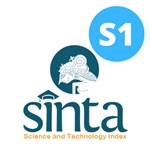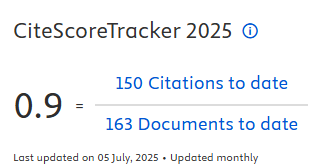Evaluation of the Physical Work Environment of Miners in Kutai Kartanegara, East Kalimantan
Downloads
Introduction: Mining is a field of work that has a high potential of risk, both in terms of health risks and safety risks. In its business processes, environmental factors are one of the potential risks that cannot be avoided by every employee. Physical work environment factors are everything around the workplace that can affect workers, either directly or indirectly, and can cause health problems such as headaches, dizziness, nausea, shortness of breath, fatigue, and dehydration. This study aims to determine the physical environmental factors that greatly influence employee productivity. Methods: This study used quantitative methods and the secondary data. Measurement of physical factors applied the standard Threshold Limit Value (TLV) in accordance with the Regulation of the Minister of Manpower of the Republic of Indonesia Number 05 of 2018. Measurements were carried out in the workshop areas, ports, heavy equipment units, and office spaces of each department. In this study, measurements of physical climate include work climate, placement, and lighting. Results: The physical work environment is found to be good enough despite being below the standard in some areas, e.g., the lighting at the administration desk, the noise in the generator room, and some heavy equipment such as bulldozers and dump trucks. Conclusions: The physical work environment is still considered safe and will not cause health problems. However, the arrangement of lighting conditions, work climate, and noise can be improved to meet the overall OHS standards and the evaluation of other work environment factors.Keywords: literature review, metal industry, occupational contact dermatitis.
Ariestyajuni, A. (2019) ‘Dampak Pajanan Kebisingan Mesin Extruder Terhadap Gangguan Komunikasi Pada Pekerja di PT X Sidoarjo', Medical Technology and Public Health, 3(1), pp. 17–22.
Extrada, E. et al. (2021) ‘Analisis Dampak Intensitas Pencahayaan Ruangan Farmasi Dengan Keluhan Kelelahan Mata Pada Pekerja Di Rumah Sakit Mesra Kabupaten Kampar Tahun 2020', Al-Tamimi Kesmas: Jurnal Ilmu Kesehatan Masyarakat (Journal of Public Health Sciences), 9(1), pp. 50–56.
Faritsy, A. Z. Al and Nugroho, Y. A. (2017) ‘Pengukuran Lingkungan Kerja Fisik dan Operator Untuk Menentukan Waktu Istirahat Kerja', Jurnal Ilmiah Teknik Industri, 16(2), pp. 108–114.
Fathimah, A., Ramadhani, T. A. and Ginanjar, R. (2018) ‘Hubungan Kebisingan Dengan Keluhan Non-Auditory Effect Pada Pekerja Bagian Weaving Di PT Unitex Bogor', PROMOTOR: Jurnal Mahasiswa Kesehatan Masyarakat, 1(2), pp. 74–79.
Hamdi, H. N. (2013) ‘Faktor-Faktor Lingkungan Kerja Fisik dan Pengaruhnya Terhadap Produktivitas Kerja Karyawan Pada Harian Lombok Post di Mataram', Jurnal Valid, 10(2), pp. 29–28.
Haryani, S. (2020) ‘Tingkat Suhu Tambang Dalam dan Keluhan Subjektif Pekerja Tambang Dalam PT AIC Jaya Kota Sawahlunto', Ensiklopedia of Journal, 2(3), pp. 186–192.
Hijah, N. F., Setyaningsih, Y. and Jayanti, S. (2021) ‘Iklim Kerja , Postur Kerja , dan Masa Kerja Terhadap Kelelahan Kerja pada Pekerja Bengkel Las', Jurnal Penelitian dan Pengembangan Kesehatan Masyarakat Indonesia, 2(1269), pp. 11–16.
Ikhssani, A. (2019) ‘Bahaya Potensial Fisik pada Proses Pengolahan Kelapa Sawit PT Perkebunan Nusantara VII Tahun 2019', Preventif: Jurnal Kesehatan Masyarakat, 10(2), pp. 95–103.
International Labour Organization (2013) Occupational Health and Safety (Tools for Productivity), Jakarta: International Labour Organization.
Lady, L. and Wiyanto, A. S. (2019) ‘Tingkat Kelelahan Kerja Pada Pekerja Luar Ruangan Dan Pengaruh Lingkungan Fisik Terhadap Peningkatan Kelelahan', Journal Industrial Servicess, 5(1), pp. 58–64.
Martian, E. and Suri, F. (2017) ‘Pengaruh Pencahayaan Ruang Kerja Terhadap Stres Kerja Karyawan Biro Perencanaan dan Kerjasama Universitas Sumatera Utara', Jurnal Diversita, 3(2), pp. 9–14.
Mentari, A. P., Imran, R. A. and Raharjo, K. (2018) ‘Evaluasi Penerapan K3 Lingkungan Kerja Faktor Fisika pada Proses Produksi Karet di PT. PN IX Krumput', in Seminar Nasional K3 - SHEA, pp. 51–59.
Minister of Manpower Regulation (2018) Nomor 5 Tahun 2018 Keselamatan dan Kesehatan Kerja Lingkungan Kerja, Jakarta: Minister of Manpower Republic of Indonesia.
Nasution, M. (2019) ‘Ambang Batas Kebisingan Lingkungan Kerja Agar Tetap Sehat Dan Semangat Dalam Bekerja', Buletin Utama Teknik, 15(1), pp. 87–90.
Nurdinati, A. Q. and Santoso, K. H. (2016) ‘Evaluasi Lingkungan Fisik untuk Meningkatkan Kinerja Karyawan pada PLTU Unit 1 dan 2 PT. Indonesia Power UBP Semarang', Industrial Engineering Online Journal, 5(3), pp. 1–6.
Pitaloka, A. and Sididi, M. (2021) ‘Hubungan Iklim dengan Kinerja Pekerja di PT. Pelabuhan Indonesia (Persero) Terminal Peti Kemas Makassar', Window of Public Health Journal, pp. 1203–1213.
Setyaningrum, I., Widjasena, B. and Suroto, S. (2014) ‘Analisa Pengendalian Kebisingan Pada Penggerindaan Di Area Fabrikasi Perusahaan Pertambangan', Jurnal Kesehatan Masyarakat (e-Journal), 2(4), pp. 267–275.
Suma'mur (2004) Higene Perusahaan dan Kesehatan Kerja (HIPERKES). Jakarta: CV Sagung Seto.
Sunaryo, M. and Rhomadhoni, M. N. (2020) ‘Gambaran Dan Pengendalian Iklim Kerja Dan Keluhan Kesehatan Pada Pekerja', Medical Technology and Public Health Journal, 4(2), pp. 171–180.
Sunaryo, M. and Sahri, M. (2019) ‘Evaluasi Iklim Kerja di Bagian Produksi pada Industri Keramik di Wilayah Gresik', ARTERI : Jurnal Ilmu Kesehatan, 1(1), pp. 29–35.
Sutrisno, E., Tirta, A. and Haryandi (2020) ‘Evaluasi Penerapan Permenaker No. 5 Tahun 2018 di PT. XYZ Pabrik Pengolahan Padi Dan Jagung Cabang Sumbawa Nusa Tenggara Barat', Jurnal Tambora, 4(3), pp. 41–50.
Ulfah, M. and Heriziana (2018) ‘Analisis Faktor Lingkungan Fisik Terhadap Risiko Stress Kerja Di CV. Natural Palembang Tahun 2017', Jurnal Formil (Forum Ilmiah) KesMas Respati, 3(2), pp. 111–116.
Urianti, S. and Simbolon, B. H. (2021) ‘Hubungan Lingkungan Fisik Dan Karakteristik Karyawan Dengan Produktivitas Kerja Di Home Industri Kerajinan Gerabah', Ruwa Jurai: Jurnal Kesehatan Lingkungan, 15(1), pp. 28–33.
Wahyuni, S. E., Kurniawan, B. and Ekawati (2014) ‘Analisis Faktor Intensitas Penerangan Lokal terhadap Kelelahan Mata di Industri Pembuatan Sepatu "X” Kota Semarang', Jurnal Kesehatan Masyarakat, 2(6), pp. 358–363.
Wandani, D. T., Sabilu, Y. and Munandar, S. (2017) ‘Hubungan Pencahayaan, Kebisingan, Suhu Udara Dengan Terjadinya Stress Kerja Pada Pekerja di PT.her Tofico Pelabuhan Perikanan Samudera (PPS) Tahun 2016', Jimkesmas : Jurnal Ilmiah Mahasiswa Kesehatan Masyarakat, 2(6), pp. 1–9.
Widiyantoro, H., Mulyadi, E. and Vidiyanti, C. (2017) ‘Analisis Pencahayaan Terhadap Kenyamanan Visual Pada Pengguna Kantor (Studi Kasus: Kantor PT Sandimas Intimitra Divisi Marketing di Bekasi)', Jurnal Arsitektur, Bangunan & Lingkungan, 6(2), pp. 65–70.
Wuladani, W. et al. (2015) ‘Dampak Kebisingan Terhadap Fungsi Pendengaran Dan Tekanan Darah Pada Pekerja Tyre di Workshop PT Rahman Abdijaya di Kabupaten Tabalong', EnviroScienteae, 11(2), pp. 122–130.
Copyright (c) 2022 The Indonesian Journal Of Occupational Safety and Health

This work is licensed under a Creative Commons Attribution-NonCommercial-ShareAlike 4.0 International License.

In order to be accepted and published by The Indonesian Journal of Occupational Safety and Health, Author(s) who submit an article should complete all the review process. The copyright of received articles assigned to the The Indonesian Journal of Occupational Safety and Health and Department of Safety and Health, Universitas Airlangga as publishers of the journal. The intended copyright includes the rights to publish articles in various forms (including reprints).
The Editorial Team of The Indonesian Journal Of Occupational Safety and Health and Department of Safety and Health strive to ensure that no errors occur in the articles that have been published, both data errors and statements in the article.
Users of this website will be licensed to use materials from this website following the Creative Commons Attribution-NonCommercial-ShareAlike 4.0 International License. No fees charged. Please use the materials accordingly.
------------------------------------------------------------------------------------------------------------------------------------------------------------------------------------------
Attribution ” You must give appropriate credit, provide a link to the license, and indicate if changes were made. You may do so in any reasonable manner, but not in any way that suggests the licensor endorses you or your use.
NonCommercial ” You may not use the material for commercial purposes.
ShareAlike ” If you remix, transform, or build upon the material, you must distribute your contributions under the same license as the original.







 How to Submit Articles in OJS
How to Submit Articles in OJS

























